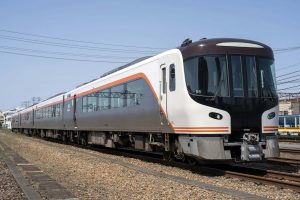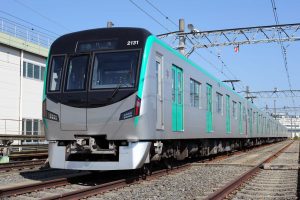JRC 2023 Blue Ribbon Prize and Laurel Prize
May 25, 2023
Japan Railfan Club, President Hiroshi Saeki, approximately three thousand members, awarded 2023 Blue Ribbon Prize to CentralJapan Railway Company HC85 series,as the most excellent rolling stock.
Also, Kyoto Municipal Transportation Bureau’s 20 series have chosen 2023 Laurel Prize as excellent rolling stock.
These awards were decided by the Blue Ribbon Prize & Laurel Prize Selection Committee of JRC (BR&LPSC). Also Blue Ribbon Prize chosen based on the club member’s vote as the best rolling stock, while Laurel Prize chosen by discussion of BR&LPSC members as recognizing excellence equipment.
“The 66th” Blue Ribbon Prize
CentralJapan Railway Company HC85 series
“The 63nd” Laurel Prize
Kyoto Municipal Transportation Bureau’s 20 series
Blue Ribbon Prize
CentralJapan Railway Company HC85 series
The JR Tokai HC85 series is a non-electrified line limited express vehicle developed as a replacement for the Kiha 85 series that has been used on the Takayama Main Line [Hida] and Kisei Main Line [Nanki]. It achieved 120km/h, the highest speed in Japan for a hybrid system vehicle equipped with a generator and storage battery. Although it is a hybrid car, each device is downsized and integrated, placed under the floor, and there is only a minimum of equipment such as an air conditioner on the roof. Compared to the Kiha 85 series, the number of engines per car is halved, contributing to improved fuel efficiency, reduced environmental impact, and reduced noise inside and outside the car. In addition, the engine is equipped with two-tier anti-vibration rubber that sandwiches the suspension frame, greatly reducing vibration and noise and improving the cabin environment.
The car body is made of stainless steel with a flat surface, and the front car is only a penetrating type to increase the freedom of formation. The shape of the head is made up of soft curves in the image of “Wa”, and it doesn’t feel like a penetrating shape, and the white and orange lines that flow like sense of dynamism.
Green cars have green and purple gradation seats, and ordinary cars have orange gradation seats. In addition, the deck has a calm wood grain color scheme, and has an exhibition space named “Nano Museum” for traditional crafts along the line. In addition, we are working to enhance the barrier-free, universal design of the wheelchair space and multifunctional restrooms. Green car Both ordinary cars are equipped with power outlets in all seats, in-car Wi-Fi service, luggage space for large luggage, and other equipment that supports modern travel.
The bogie uses a bogie frame that reduces the amount of welding and improves reliability and maintainability. The axle box support by a tandem type, and the vertical, horizontal, and front/rear springs can be set optimally. The emergency call device, security cameras are installed in the cabins and decks, and not only the crew but also the command center can check in real time via the communication system, making it possible to respond quickly in the event of an emergency. We are improving safety. This communication system can be constantly monitored status of main equipment such as engines, and other main system which contributes to early detection of malfunctions and rolling stock maintenance. The information can be conveyed to passengers.
It received the most support from member votes, and the selection committee evaluated it as the most excellent vehicle worthy of the Blue Ribbon Award from many perspectives.
Laurel Prize
Kyoto Municipal Transportation Bureau’s 20 series
Kyoto Municipal Transportation Bureau’s 20 series is a vehicle developed for the purpose of replacing the 10 series introduced when the subway Karasuma line opened in 1981. The first 20 series started operation from March 26, 2022. To providing barrier-free access and multilingual guide displays for foreign visitors, also brilliantly utilizes Kyoto’s traditional industrial materials and techniques for exterior and interior design.
At the design process, in fiscal 2017 and 2018, it set up the “Design Council for the New Construction of Karasuma Line Cars,” that members consisted of industrial design experts and publicly recruited citizens. It has formulated three clear concepts: “Subway that tender for all” “a subway unique to Kyoto,” and “to create a subway that you will feel attached to.” Three plans for exterior and interior design are produced, then the final plan is determined by voting by citizens and users.
The interior is decorated with “glamorous and elegant colors”. A multi-purpose space called “Omoiyari Area” is installed between the two doors on the driver’s cab side of both leading cars, and is compatible with wheelchairs, strollers, and large luggage. The back of the standing seat in the “Omoiyari Area” is a space for decorating traditional Kyoto crafts, and 18 types of “Kyoto unique” will be displayed for each formation, including Nishijin woven Kiyomizu ware, Kyoto folding fans, etc. Exhibition “only in Kyoto”. Kyoto inlays are used for the car number and operator markings in both leading cars, while nails are hidden in the upper passages of the intermediate cars, and Kitayama logs and Kyo-kumihimo are used for the sheaths of the straps. Even outside the car, metal craft hammers are used for the Transportation Bureau emblem. These will increase opportunities for people to feel more familiar with traditional industries,
The exterior has become “a more near-future image with many curved surfaces in the front molding”. The structure is a double-skin structure made of aluminum alloy, and more than 90% is made of mono-alloy, so recycling is taken into consideration. Compared to the 10 series, floor level lowered by 60 mm to reduce the difference in level with the platform, Doors colored emerald green so that it can be easily recognized.The vehicle is controlled by a speed sensorless VVVF device using hybrid SiC, using a fully enclosed electric motor, and is compatible with future ATO operation.
In this way, within the restrictions of commuter vehicles of public transport operators, design formulation with citizen participation, installation of multi-purpose spaces, barrier-free, for foreigner such as multilingual guidance display, and traditional industrial products in vehicle interior and exterior design It was selected for the Laurel Prize in recognition of its high degree of perfection, such as co-creation, and its excellent combination of cutting-edge technology and the essence of Kyoto.



